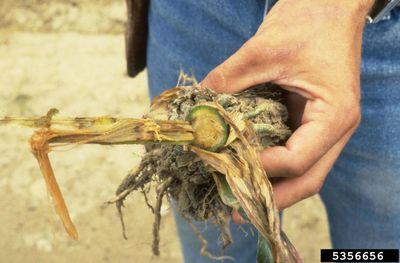About Stalk Rot in Sweet Corn
Rotting corn stalks can be caused by fungal or bacterial pathogens. The most common cause of sweet corn with rotting stalks is a fungal disease known as anthracnose stalk rot. This fungal disease is caused by the fungus Colletotrichum graminicola. Its most common symptom is shiny black lesions on the stalk. Spores of anthracnose stalk rot and other fungal rots rapidly grow in hot, humid conditions. They can spread by contact, insect vectors, wind, and splash back from infected soils. Another common fungal sweet corn stalk rot is fusarium stalk rot. A common symptom of fusarium stalk rot is pink lesions on the infected corn stalks. This disease can affect the whole plant and may lie dormant in corn kernels. When these kernels are planted, the disease continues to spread. A common bacterial sweet corn stalk rot disease is caused by the bacteria Erwinia chrysanthemi pv. Zeae. Bacterial pathogens enter corn plants through natural openings or wounds. They can be spread from plant to plant by insects. While these are just a few of the fungal and bacterial diseases that cause stalk rot in sweet corn, most have similar symptoms, grow in the same hot, humid conditions, and are commonly spread from plant to plant. Common symptoms of sweet corn stalk rot are discoloration of the stalk; gray, brown, black, or pink lesions on the stalk; white fungal growth on stalks; wilting or distorted corn plants; and hollow stalks that bend, break, and topple over.
Treatment for Sweet Corn with Rotting Stalks
Corn plants that are injured or stressed are more susceptible to rot diseases. Plants with too little nitrogen and/or potassium are susceptible to stalk rots, so proper fertilization can help keep plants disease free. Crop rotation can also add needed nutrients to the soil and stop the spread of diseases. Many pathogens that cause rotting corn stalks may lie dormant in the soil. Deeply tilling fields between crops can prevent the spread of disease from splash back. Since insects often play a role in spreading these diseases, pest management is an important part of controlling sweet corn stalk rot. Plant breeders have also created many new disease-resistant varieties of sweet corn.
